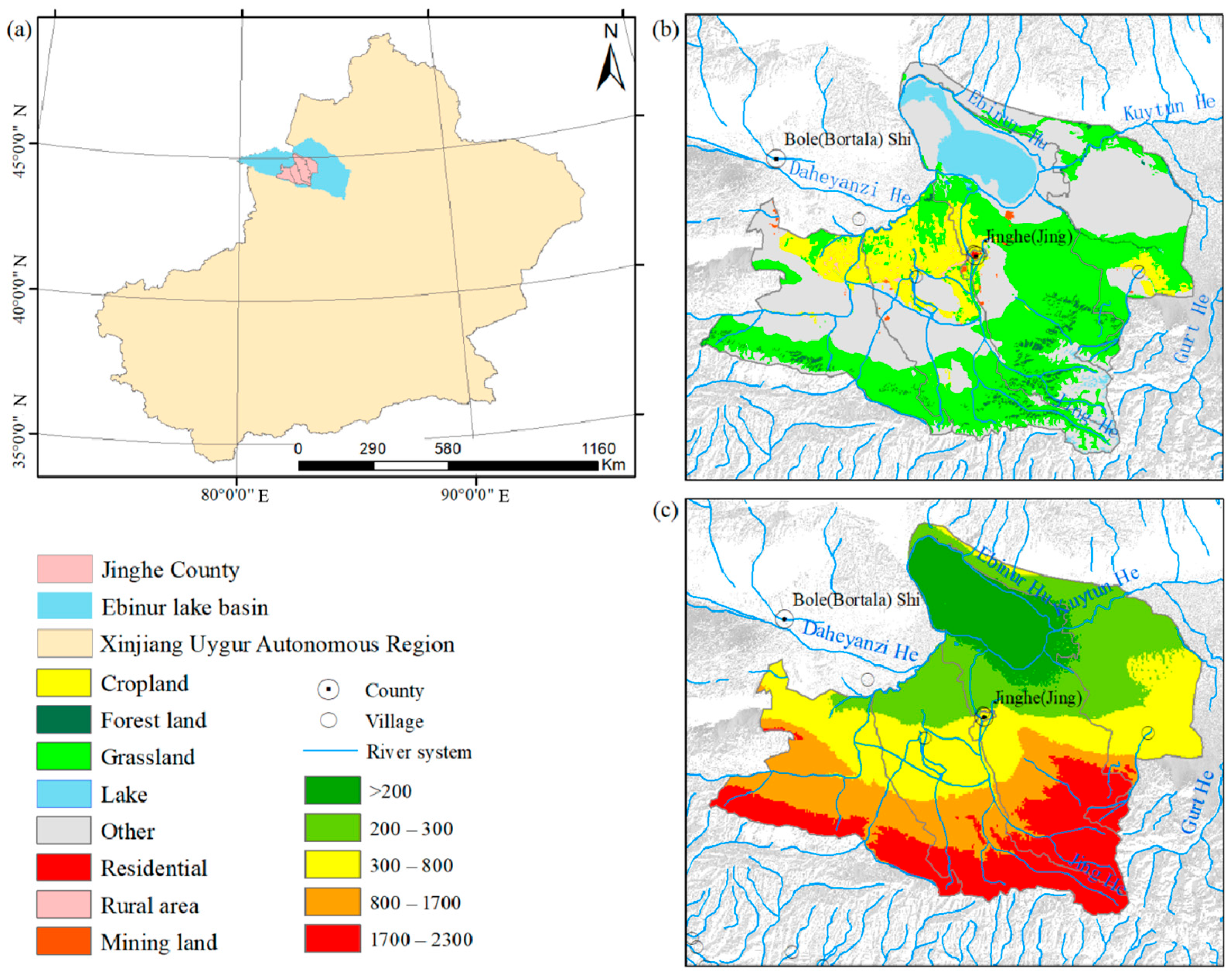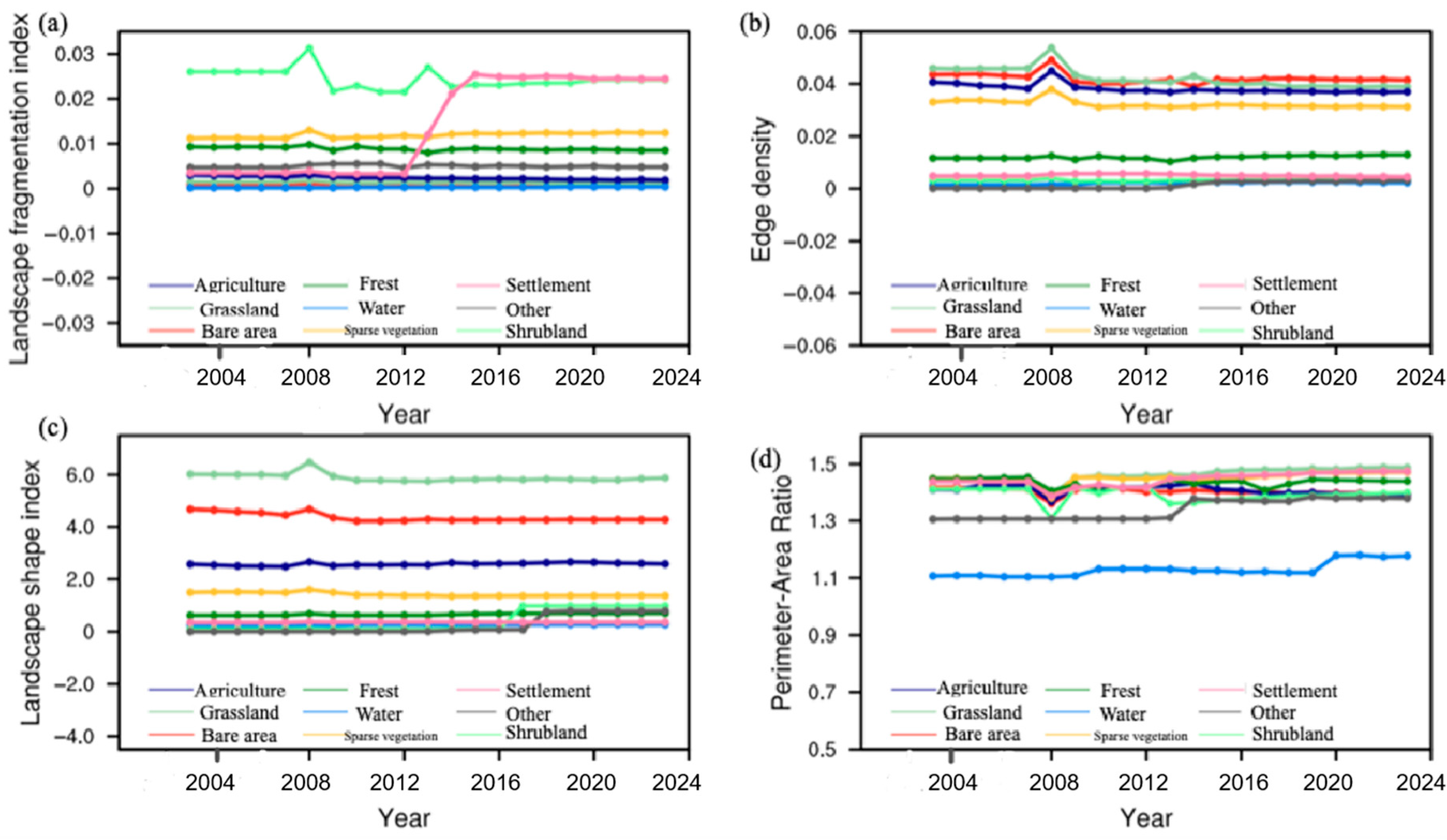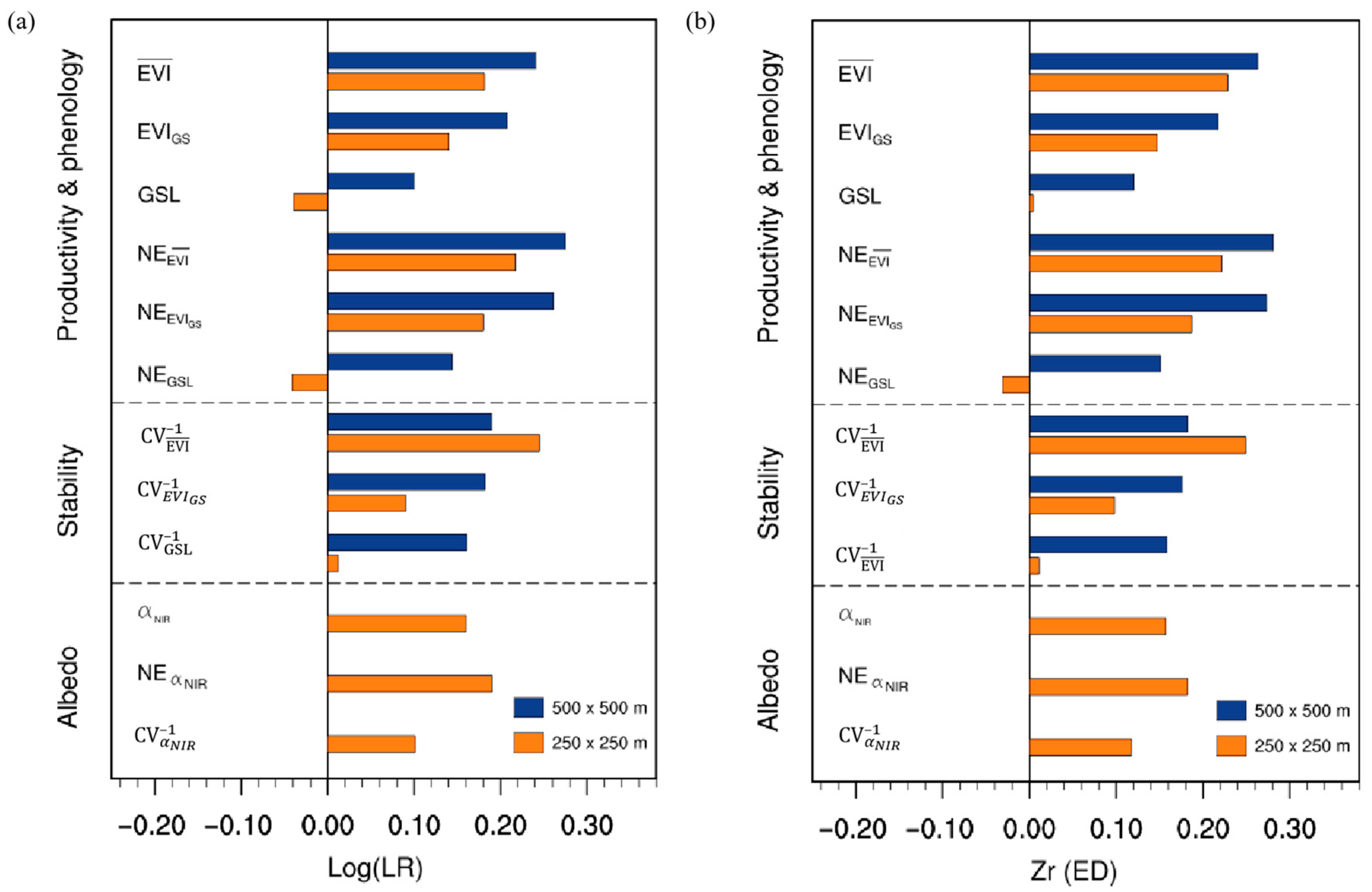Investigating the Correlation Between the Richness of Land Cover Types and Landscape Functions in Jinghe County at Different Scales
Abstract
1. Introduction
2. Data Source and Methods
2.1. Overview of the Study Area
2.2. Data Sources
2.2.1. Land Cover Dataset
2.2.2. Climate and Climate Class Datasets
2.2.3. EVI Dataset
2.2.4. Albedo Dataset
2.3. Landscape Index
3. Results
3.1. Statistical Analysis of Landscape Pattern Index
3.2. Primary Productivity and Phenology
3.3. Correlation Between Landscape Indicators and Ecosystem Functions at Different Scales
3.4. Relative Importance of Landscape Richness Effects
4. Conclusions and Discussion
4.1. Conclusions
- The landscape pattern changes in the study area over the past two decades have shown phased characteristics. From 2003 to 2008 and from 2013 to 2018, landscape transformation was relatively weak. From 2008 to 2013, transformation intensified, with a significant shift from water bodies to sparse vegetation. From 2018 to 2023, the areas of grassland, residential land, and water bodies have increased. These changes reflect the dynamic responses of the landscape ecosystem under the combined influence of natural disturbances, ecological restoration, and human activities.
- Landscape diversity has a stronger explanatory power for EVI_AVG at a resolution of 250 × 250 m. Under different landscape functions and scales, the impact of log (LR) on ecosystem productivity and phenological indicators shows significant differences. Generally speaking, as the spatial scale increases, the positive effect of NE strengthens and its association with landscape patterns becomes more intimate. However, the response of NE related to phenology to landscape patterns is more complex, with its mean value decreasing as the scale increases.
- At the sampling scales of 250 × 250 m and 500 × 500 m, there are varying degrees of correlations among landscape pattern indices, environmental factors, and between the two. The smaller scale more accurately reflects the local features and the influence of micro-environment on the landscape, while the larger scale focuses on the overall pattern and the general association between the regional environment and the landscape. Scale changes influence both the direction and significance of ecological correction
- Under the two landscape plot scales of 250 × 250 m and 500 × 500 m, the overall direction of ecological effects is consistent, but certain differences are manifested. Meanwhile, scale changes can regulate the direction and significance level of the correlation of ecological processes. Combining the analysis of the two scales helps to understand the multi-scale characteristics of ecological processes at different spatial levels more comprehensively.
4.2. Discussion
Author Contributions
Funding
Institutional Review Board Statement
Informed Consent Statement
Data Availability Statement
Conflicts of Interest
References
- Nepali, B.R.; Skartveit, J.; Baniya, C.B. Impacts of slope aspects on altitudinal species richness and species composition of Narapani-Masina landscape, Arghakhanchi, West Nepal. J. Asia-Pac. Biodivers. 2021, 14, 415–424. [Google Scholar] [CrossRef]
- Santos, J.P.; Sobral-Souza, T.; Brown, K.S., Jr.; Vancine, M.H.; Ribeiro, M.C.; Freitas, A.V. Effects of landscape modifi-cation on species richness patterns of fruit-feeding butterflies in Brazilian Atlantic Forest. Divers. Distrib. 2020, 26, 196–208. [Google Scholar] [CrossRef]
- Rodríguez, S.L.; van Bussel, L.G.; Alkemade, R. Classification of agricultural land management systems for global modeling of biodiversity and ecosystem services. Agric. Ecosyst. Environ. 2024, 360, 108795. [Google Scholar] [CrossRef]
- Sahle, M.; Yeshitela, K. Dynamics of land use land cover and their drivers study for management of ecosystems in the socio-ecological landscape of Gurage Mountains, Ethiopia. Remote Sens. Appl. Soc. Environ. 2018, 12, 48–56. [Google Scholar] [CrossRef]
- Wang, Q.; Wang, H. Spatiotemporal dynamics and evolution relationships between land-use/land cover change and landscape pattern in response to rapid urban sprawl process: A case study in Wuhan, China. Ecol. Eng. 2022, 182, 106716. [Google Scholar] [CrossRef]
- Mendoza-Ponce, A.; Corona-Núñez, R.; Kraxner, F.; Leduc, S.; Patrizio, P. Identifying effects of land use cover changes and climate change on terrestrial ecosystems and carbon stocks in Mexico. Glob. Environ. Change 2018, 53, 12–23. [Google Scholar] [CrossRef]
- Le Provost, G.; Thiele, J.; Westphal, C.; Penone, C.; Allan, E.; Neyret, M.; van der Plas, F.; Ayasse, M.; Bardgett, R.D.; Birkhofer, K.; et al. Contrasting responses of above- and belowground diversity to multiple components of land-use intensity. Nat. Commun. 2021, 12, 3918. [Google Scholar] [CrossRef] [PubMed]
- Tammaru, T.; Valdma, D.; Tiitsaar, A.; Kaasik, A.; Õunap, E.; Remm, J.; Teder, T. Landscape-level determinants of butterfly species richness in northern Europe: A country-wide survey reveals the paramount importance of forest land. Biol. Conserv. 2023, 286, 110294. [Google Scholar] [CrossRef]
- Dem, P.; Hayashi, K.; Fujii, M.; Mohmmed, E.E.E. Integrating biodiversity and ecosystem services in land use change assessment through sustainability indicator. Environ. Impact Assess. Rev. 2025, 114, 107971. [Google Scholar] [CrossRef]
- Sõber, V.; Leps, M.; Kaasik, A.; Mänd, M.; Teder, T. Forest proximity supports bumblebee species richness and abundance in hemi-boreal agricultural landscape. Agric. Ecosyst. Environ. 2020, 298, 106961. [Google Scholar] [CrossRef]
- van Strien, M.J.; Slager, C.T.; De Vries, B.; Grêt-Regamey, A. An improved neutral landscape model for recreating real landscapes and generating landscape series for spatial ecological simulations. Ecol. Evol. 2016, 6, 3808–3821. [Google Scholar] [CrossRef]
- Oita, S.; Ibáñez, A.; Lutzoni, F.; Miadlikowska, J.; Geml, J.; Lewis, L.A.; Hom, E.F.Y.; Carbone, I.; U’Ren, J.M.; Arnold, A.E. Climate and seasonality drive the richness and composition of tropical fungal endophytes at a landscape scale. Commun. Biol. 2021, 4, 313. [Google Scholar] [CrossRef]
- Bellón, B.; Henry, D.A.; Renaud, P.-C.; Roque, F.d.O.; Santos, C.C.; Melo, I.; Arvor, D.; de Vos, A. Landscape drivers of mammal habitat use and richness in a protected area and its surrounding agricultural lands. Agric. Ecosyst. Environ. 2022, 334, 107989. [Google Scholar] [CrossRef]
- Zimbres, B.; Peres, C.A.; Machado, R.B. Terrestrial mammal responses to habitat structure and quality of remnant riparian forests in an Amazonian cattle-ranching landscape. Biol. Conserv. 2017, 206, 283–292. [Google Scholar] [CrossRef]
- Mu, T.; Zhao, R.; Li, H.; Lei, Y.; Chen, Q.; Tian, G.; Zhang, Y.; Mu, B. A Novel Indicator for Assessing Spatial Coupling Relationships within Hybrid Landscapes Comprising Diverse Land Cover Types and Its Application to Explaining Urban Thermal Environment. Sustain. Cities Soc. 2025, 130, 106595, Correction in Sustain. Cities Soc. 2025, 132, 106828. [Google Scholar] [CrossRef]
- Cui, Y.; Zhao, C.; Pan, Y.; Ma, K.; Liu, X.; Gu, X. Decoding spatial consistency of multi-Source land cover products in China: Insights from heterogeneous landscapes. Int. J. Appl. Earth Obs. Geoinf. 2025, 139, 104529. [Google Scholar] [CrossRef]
- Coelho, A.J.P.; Teixeira, H.M.; Verweij, P.; Matos, F.A.R.; Villa, P.M.; Meira-Neto, J.A.A. Functional richness mediates landscape and management effects on tree biomass and soil fertility during secondary forest succession. Ecol. Indic. 2024, 162, 112029. [Google Scholar] [CrossRef]
- Gong, J.; Jin, T.; Cao, E.; Wang, S.; Yan, L. Is ecological vulnerability assessment based on the VSD model and AHP-Entropy method useful for loessial forest landscape protection and adaptative management? A case study of Ziwuling Mountain Region, China. Ecol. Indic. 2022, 143, 109379. [Google Scholar] [CrossRef]
- Risal, A.; Karki, R.; Qi, J. Integrating remote sensing data with watershed-scale ecohydrological modeling in diverse forest and agricultural landscapes of the Upper Mississippi River Basin. Environ. Model. Softw. 2025, 192, 106588. [Google Scholar] [CrossRef]
- Zhang, Y. Quantitative analysis of surface landscape elements for landscape environmental design—Based on high resolution remote sensing image technology. Syst. Soft Comput. 2025, 7, 200325. [Google Scholar] [CrossRef]
- Guo, J.; Huang, W.; Dong, Y.; Lin, K.; Yue, F.; Shan, Y.; Liu, H.; Hao, Z.; Wang, N.; Ding, X. A weight-adaptive updated method for grasshopper habitat mapping at the national scale using remote sensing: Combined with spatial heterogeneity and landscape. ISPRS J. Photogramm. Remote Sens. 2025, 227, 84–98. [Google Scholar] [CrossRef]
- Cheng, S.; Yang, X.; Yang, G.; Chen, B.; Chen, D.; Wang, J.; Ren, K.; Sun, W. Using ZY1-02D satellite hyperspectral remote sensing to monitor landscape diversity and its spatial scaling change in the Yellow River Estuary. Int. J. Appl. Earth Obs. Geoinf. 2024, 128, 103716. [Google Scholar] [CrossRef]
- Halder, S.; Bose, S. Remote sensing insights for sustainable development: Water quality and landscape dynamics in Mirik Lake, Darjeeling District, West Bengal, India. Clean. Water 2024, 2, 100024. [Google Scholar] [CrossRef]
- Ren, Y.; Zhang, F.; Kung, H.-T.; Johnson, V.C.; Wang, J.; Zhang, Y.; Yu, H.; Yushanjiang, A. Using the vegetation-solar radiation (VSr) model to estimate the short-term gross primary production (GPP) of vegetation in Jinghe county, XinJiang, China. Ecol. Eng. 2017, 107, 208–215. [Google Scholar] [CrossRef]
- Wang, Z.; Zhang, X.; Zhang, F.; Chan, N.W.; Kung, H.-T.; Liu, S.; Deng, L. Estimation of soil salt content using machine learning techniques based on remote-sensing fractional derivatives, a case study in the Ebinur Lake Wetland National Nature Reserve, Northwest China. Ecol. Indic. 2020, 119, 106869. [Google Scholar] [CrossRef]
- Lin, Q.; Xu, W. Analysis of the effect of the quantity of inflow into Ebinur Lake on its ecological security. Environ. Res. 2025, 266, 120517. [Google Scholar]
- Zhang, F.; Yushanjiang, A.; Jing, Y. Assessing and predicting changes of the ecosystem service values based on land use/cover change in Ebinur Lake Wetland National Nature Reserve, Xinjiang, China. Sci. Total. Environ. 2019, 656, 1133–1144. [Google Scholar] [CrossRef] [PubMed]
- Oehri, J.; Bürgin, M.; Schmid, B.; Niklaus, P.A. Local and landscape-level diversity effects on forest functioning. PLoS ONE 2020, 15, e0233104. [Google Scholar] [CrossRef] [PubMed]
- Oehri, J.; Schmid, B.; Schaepman-Strub, G.; Niklaus, P.A. Terrestrial land-cover type richness is positively linked to landscape-level functioning. Nat. Commun. 2020, 11, 154. [Google Scholar] [CrossRef]
- Habibie, M.I.; Nurda, N.; Fernando, D.; Arifandri, R.; Putra, P.K.; Prayogi, H.; Sencaki, D.B. Integrating Sentinel-2 and ESA world cover for effective land use and land cover assessment using machine learning. Adv. Space Res. 2025, 76, 4925–4958. [Google Scholar] [CrossRef]
- Mousivand, A.; Arsanjani, J.J. Insights on the historical and emerging global land cover changes: The case of ESA-CCI-LC datasets. Appl. Geogr. 2019, 106, 82–92. [Google Scholar] [CrossRef]
- Reinhart, V.; Fonte, C.; Hoffmann, P.; Bechtel, B.; Rechid, D.; Boehner, J. Comparison of ESA climate change initiative land cover to CORINE land cover over Eastern Europe and the Baltic States from a regional climate modeling perspective. Int. J. Appl. Earth Obs. Geoinf. 2021, 94, 102221. [Google Scholar] [CrossRef]
- Tan, M.L.; Tew, Y.L.; Chun, K.P.; Samat, N.; Shaharudin, S.M.; Mahamud, M.A.; Tangang, F.T. Improvement of the ESA CCI Land cover maps for water balance analysis in tropical regions: A case study in the Muda River Basin, Malaysia. J. Hydrol. Reg. Stud. 2021, 36, 100837. [Google Scholar] [CrossRef]
- Copernicus Climate Change Service, Climate Data Store. Land Cover Classification Gridded Maps from 1992 to Present Derived from Satellite Observation; Copernicus Climate Change Service (C3S) Climate Data Store (CDS). 2019. Available online: https://cds.climate.copernicus.eu/datasets/satellite-land-cover?tab=download (accessed on 8 May 2024).
- Sun, L.; Wei, J.; Duan, D.; Guo, Y.; Yang, D.; Jia, C.; Mi, X. Impact of Land-Use and Land-Cover Change on urban air quality in representative cities of China. J. Atmos. Sol.-Terr. Phys. 2016, 142, 43–54. [Google Scholar] [CrossRef]
- Lan, G.; Liang, Y.; Ma, Y. Assessment of precipitation reanalysis product ERA5 on summer extreme precipitation in the Yellow River Basin. Dyn. Atmos. Oceans 2025, 112, 101603. [Google Scholar] [CrossRef]
- Ding, A.; Liang, S.; Ma, H.; He, T.; Jia, A.; Wang, Q. Improved estimation of daily blue-sky snow shortwave albedo from MODIS data and reanalysis information. Sci. Remote Sens. 2024, 10, 100163. [Google Scholar] [CrossRef]
- Peng, S.; Ding, Y.; Liu, W.; Li, Z. 1 km monthly temperature and precipitation dataset for China from 1901 to 2017. Earth Syst. Sci. Data 2019, 11, 1931–1946. [Google Scholar] [CrossRef]
- Riitters, K.; Vogt, P. Mapping landscape ecological patterns using numeric and categorical maps. PLoS ONE 2023, 18, e0291697. [Google Scholar] [CrossRef]
- Hersperger, A.M.; Grădinaru, S.R.; Daunt, A.B.P.; Imhof, C.S.; Fan, P. Landscape ecological concepts in planning: Review of recent developments. Landsc. Ecol. 2021, 36, 2329–2345. [Google Scholar] [CrossRef]
- Zhang, Y.; Tariq, A.; Hughes, A.C.; Hong, D.; Wei, F.; Sun, H.; Sardans, J.; Peñuelas, J.; Perry, G.; Qiao, J.; et al. Challenges and solutions to biodiversity conservation in arid lands. Sci. Total. Environ. 2023, 857, 159695. [Google Scholar] [CrossRef]
- Wang, C.; Gu, H.; Bian, Z.; Zhang, Y.; Guan, D.; Liu, X. Threshold effects of multi-scale landscape pattern on cultivated land ecosystem service in the Northeast Black Soil Region of China. Ecol. Indic. 2025, 180, 114298. [Google Scholar] [CrossRef]
- Geng, X.; Zhang, D.; Gao, J.; Yuan, Y.; Li, C.; Li, X.; Wang, X. Quantifying the impact of landscape pattern on land surface temperature: An integrated landscape index from perspective of scale response and threshold effect. Urban For. Urban Green. 2025, 113, 129073. [Google Scholar] [CrossRef]








| Nu | Landscape Metric | Calculation Formula | The Meaning of Landscape Pattern Metrics |
|---|---|---|---|
| 1 | Landscape fragmention index | Landscape fragmentation serves as an indicator of how fragmented a landscape becomes, reflecting the complexity of its spatial configuration and, to some extent, the extent of human impact on landscape patterns. Increased landscape fragmentation is a major driver behind the loss of biodiversity and is strongly associated with the sustainable management and conservation of natural resources. | |
| 2 | Edge Density (ED) | This index not only indicates the complexity of the spatial configuration within the landscape sample plots but also, to some degree, represents the stability of the overall spatial structure of the landscape pattern. | |
| 3 | Landscape shape index | ||
| 4 | Landscape fractal dimension (PAFRAC) | To some extent, this indicator can represent the level of disruption that human activities impose on the landscape pattern. Theoretically, the fractal dimension values fall within the range of 1 to 2. |
| Category | Landscape Function Index | Scale of Landscape Sampling Area | NE > 0 Effect (Mean ± s.e.m.) a | NE > 0 Effect Significance (One-Sample t-Test) a | Linear Effect of Log(LR) on NE (Mean ± s.e.m.) a | Linear Effect of Log(LR) on NE Significance (F-Test) a |
|---|---|---|---|---|---|---|
| Productivity | EVI_AGV | 250 × 250 | 0.227 ± 0.004 | t19 = 6.0; p < 0.001 | 0.453 ± 0.015 | F1,18 = 6.1; p < 0.001 |
| 500 × 500 | 0.357 ± 0.007 | t16 = 2.0; p = 0.04 | 0.711 ± 0.024 | F1,15 = 3.2; p < 0.001 | ||
| EVI_GS | 250 × 250 | 0.281 ± 0.004 | t35 = 6.0; p < 0.001 | 0.085 ± 0.008 | F1,17 = 5.9; p < 0.001 | |
| 500 × 500 | 0.325 ± 0.004 | t16 = 4.0; p = 0.030 | 0.113 ± 0.0201 | F1,15 = 5.9; p < 0.001 | ||
| Phenology | EVI_GSL | 250 × 250 | 3.652 ± 3.18 | t18 = 6.0; p < 0.001 | 5.127 ± 5.621 | F1,17 = 5.9; p < 0.001 |
| 500 × 500 | 1.172 ± 2.92 | t16 = 4.0; p < 0.030 | 3.172 ± 2.932 | F1,21 = 1.53; p < 0.001 |
Disclaimer/Publisher’s Note: The statements, opinions and data contained in all publications are solely those of the individual author(s) and contributor(s) and not of MDPI and/or the editor(s). MDPI and/or the editor(s) disclaim responsibility for any injury to people or property resulting from any ideas, methods, instructions or products referred to in the content. |
© 2025 by the authors. Licensee MDPI, Basel, Switzerland. This article is an open access article distributed under the terms and conditions of the Creative Commons Attribution (CC BY) license (https://creativecommons.org/licenses/by/4.0/).
Share and Cite
Zhang, Y.; Lei, J.; Li, X. Investigating the Correlation Between the Richness of Land Cover Types and Landscape Functions in Jinghe County at Different Scales. Sustainability 2025, 17, 10196. https://doi.org/10.3390/su172210196
Zhang Y, Lei J, Li X. Investigating the Correlation Between the Richness of Land Cover Types and Landscape Functions in Jinghe County at Different Scales. Sustainability. 2025; 17(22):10196. https://doi.org/10.3390/su172210196
Chicago/Turabian StyleZhang, Yue, Jiayu Lei, and Xin Li. 2025. "Investigating the Correlation Between the Richness of Land Cover Types and Landscape Functions in Jinghe County at Different Scales" Sustainability 17, no. 22: 10196. https://doi.org/10.3390/su172210196
APA StyleZhang, Y., Lei, J., & Li, X. (2025). Investigating the Correlation Between the Richness of Land Cover Types and Landscape Functions in Jinghe County at Different Scales. Sustainability, 17(22), 10196. https://doi.org/10.3390/su172210196





